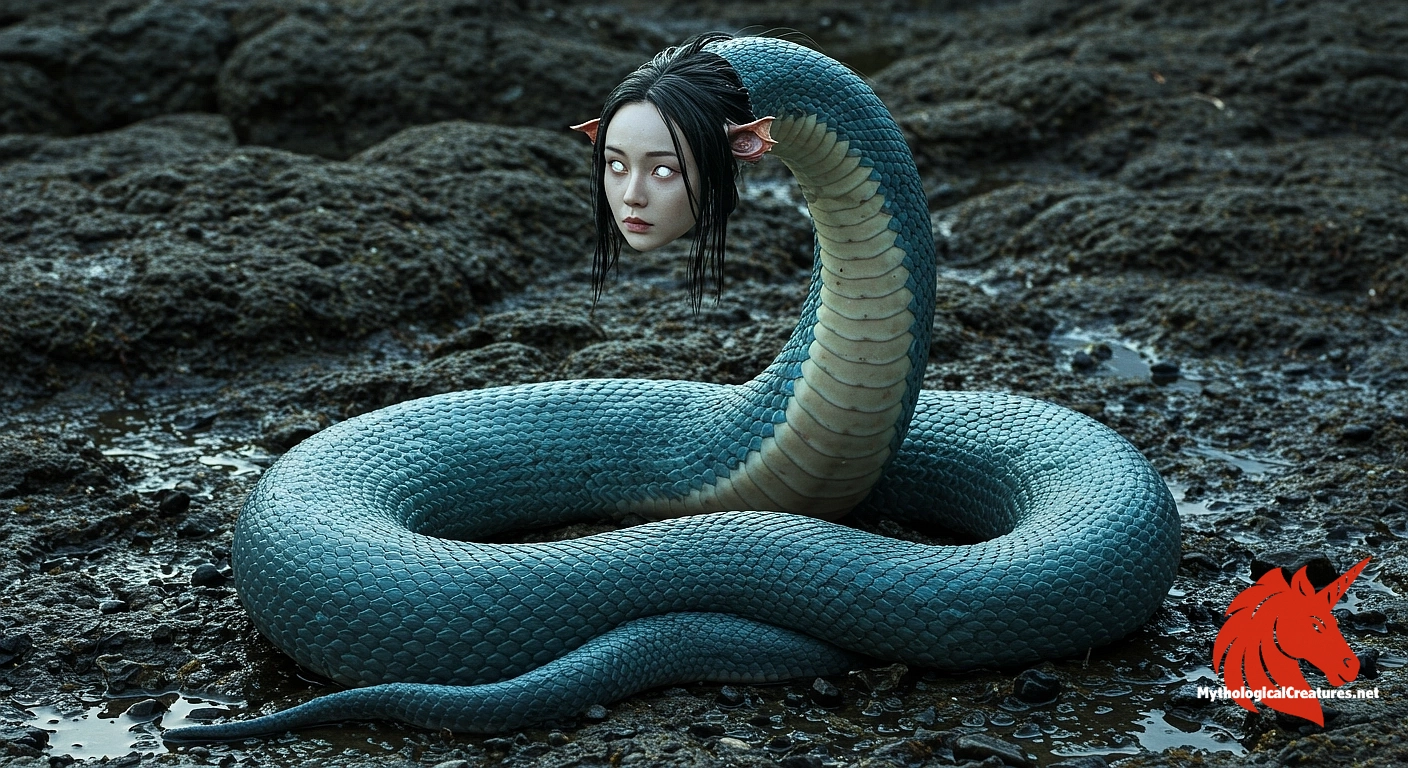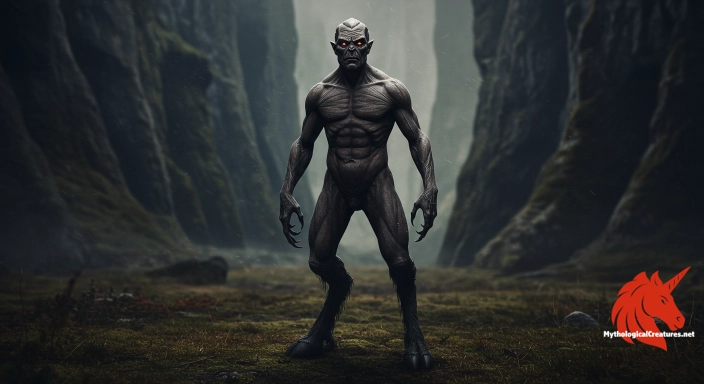Nure-onna: Nure-onna is a Japanese yōkai that appears as a wet, serpentine woman.

Nure-onna
Nure-onna - Represents the mysterious dangers of the sea and the unpredictable nature of supernatural forces.
Origins & First Encounters
Nure-onna, whose name translates as 'wet woman', occupies a striking position in the spectrum of Japanese folklore, drawing both fascination and dread from those who recount her tale. Her origins are interwoven with the waters of ancient Japan, where natural phenomena and supernatural occurrences blended to form enigmatic legends. Early attestation of her presence can be traced back to Edo period narratives, where travellers and local communities alike documented mysterious encounters along riverbanks and coastal areas. The creature emerged amid a cultural milieu that revered and feared the unpredictable forces of water, encapsulating the dual nature of life and death. Over time, her story has evolved to reflect societal anxieties about the unknown, particularly in relation to the dangerous allure of nature. In these narratives, she often serves as a warning against the seductive yet perilous embrace of the natural world. Her multifaceted character—at once alluring and ominous—has sparked countless reinterpretations and adds to the rich tapestry of Japanese yōkai mythology. The enduring legacy of Nure-onna underscores her role as both a supernatural threat and a symbol of nature's capricious beauty.
Source Texts & Tale Variants
The primary sources chronicling Nure-onna’s lore span a variety of traditional mediums, including oral storytelling, illustrated scrolls, and early printed ghost anthologies from the Edo and Meiji periods. In these ancient texts, the wet woman is depicted through a series of episodic encounters that underline her unpredictable nature and variable appearance. Folklore compilations and regional manuscripts often reveal contrasting portraitures, some suggesting a sorrowful spirit while others emphasise her predatory instincts. Several narrative strands also refer to her alternate identity as nureyomejo, particularly when she is seen at sea. The diversity in her portrayal across these sources highlights the fluidity of her myth, with different communities adapting her persona to suit local environmental and social contexts. Over centuries, the accumulation of variant tales has enriched her character, rendering her a composite figure that transcends a single fixed identity. The interplay of written records and oral traditions further reveals how her legend was reshaped continuously by successive generations. Even when the original sources are sparse or fragmented, the enduring quality of her story ensures that her myth remains a subject of both scholarly study and popular imagination.
Form & Powers
Nure-onna is distinguished by a beguiling yet unnerving amalgamation of human and reptilian traits that commands attention. Her head bears the delicate features of a woman, often described as alluring with a mysterious, almost hypnotic gaze. Long, damp hair cascades in dishevelled strands, hinting at her perpetual connection with water and the elements. Below this human visage, her body transforms into that of a sinuous snake, complete with shining, scaled skin that glistens as if perpetually wet. The convergence of soft flesh and hardened scales produces a surreal contrast, evoking both beauty and menace. Illustrations and oral depictions alike emphasize the fluidity of her form, which seems to shift between physical states depending on her surroundings. At times, her limbs and features are rendered with ambiguous proportions that blur the line between delicate femininity and the cold, instinctual nature of snakes. Variations in size and form have been recorded, with some accounts depicting her as imposing and others as deceptively slight, yet each study contributes to her mystique. The overall effect is one of an entity that is as unpredictable as the water from which she is born.
Regional Faces
Regional interpretations of Nure-onna underscore the adaptability of her myth across Japan’s varied landscapes. In coastal and seafaring regions, she is frequently identified with the dangerous forces at work in the ocean, often appearing during violent storms or in the wake of turbulent tides. Inland, legends reframe her as a spectral presence haunting misty rivers and secluded springs, thereby linking her identity with both maritime and freshwater mysteries. The alternative name nureyomejo, used in certain locales, accentuates her association with the moist, unfathomable depths of the sea. Some communities describe her as a tragic figure whose appearance is tinged with sorrow and loss, while others retain the emphasis on her lethal, carnivorous nature. Variations in narrative details—such as the style of her transformation and the nature of her encounters with humans—reflect the influence of local environmental challenges and cultural attitudes. These regional adaptations not only serve to preserve her legend but also allow it to evolve in response to specific geographical and historical contexts. In this way, Nure-onna remains a versatile symbol deeply embedded in both the folklore and daily life of diverse Japanese communities.
Cultural Parallels
When placed in a broader mythological context, Nure-onna shares intriguing parallels with legendary water spirits and hybrid creatures found around the world. Her fusion of human beauty with reptilian ferocity is reminiscent of the allure and danger embodied by mythical sirens and mermaids in European tales. Similar to the Slavic Rusalka, she represents a duality where attraction coexists with peril, inviting comparisons across cultural boundaries. Some African mythologies also feature water-associated beings who combine grace with lethal intent, emphasizing the universal symbolism of water as both source of life and agent of destruction. This common motif reveals a shared human fascination with the ambiguous forces of nature, whereby feminine beauty is both celebrated and feared. Comparative studies highlight how different societies articulate similar anxieties through the depiction of seductive beings that lure unsuspecting victims to their demise. The recurring theme of transformation—often from beauty to terror—binds these myths together, suggesting a collective cultural narrative about the unpredictability of the natural world. By examining these cross-cultural resemblances, one gains insight into how the archetype of Nure-onna resonates on a global scale, reflecting persistent human concerns about the unknown.
Legacy & Modern Evolution
The legacy of Nure-onna has transformed significantly from her early depictions as a merciless sea demon to a more layered figure in contemporary culture. In her traditional form, she embodied the raw, untamed aspects of nature and served as a dire warning of the perils lurking at the boundary between civilisation and the wild. As societal views have shifted, modern reinterpretations often explore the tragic and ambiguous dimensions of her character, revealing a haunting beauty intertwined with grief and solitude. Contemporary media—in manga, anime, and film—has embraced her image, frequently reimagining her as a complex anti-heroine rather than a mere monster. This evolution reflects broader cultural explorations of identity, gender, and the intricate relationship between humanity and the natural world. Artists and storytellers have used her myth to question traditional roles and to illustrate the multifaceted nature of allure and danger. Her presence in modern narratives illustrates how ancient folklore can be recontextualised to speak to contemporary themes, making her a versatile symbol for both horror and empathy. The enduring appeal of Nure-onna, evident in her varied portrayals, underscores a timeless fascination with myth, transformation, and the eternal interplay of beauty and terror.
Interesting Fact
The Nure-onna's dual nature as both a beautiful woman and a deadly snake challenges conventional notions of beauty and danger, making her a compelling figure in Japanese folklore.
For serious myth projects
Feature your work alongside the legends
From academic works to story-rich games, we highlight projects that respect world mythologies. Talk to us about a measured, long-term placement.
Start a conversationQuick Creature Info
Associations:
Our Mythic Legendary Rating:

Also Sometimes Known As:
Habitat:
Supernatural Powers:
Physical Attributes:
Abilities:
Behavior:
Lore:
Related Creatures, Tales or Lore
References
Discover Another Mythical Legend You May Not Have Heard Of?
Uncover the mysteries of ancient folklore and expand your knowledge of legendary beings from cultures around the world.
Dare to Meet the Black Donald....
Curated by the Mythological Creatures Team
Series editor: Mythological Creatures Directory
Primary desk: Asian & Pacific Myth Cycles Desk
(rev. November 2025)
